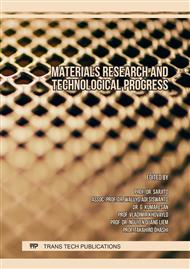[1]
UN-Water, 2018. The United Nations World Water Development Report 2018: Nature-Based Solutions for Water. UNESCO, Paris, France.
DOI: 10.18356/1f309c97-en
Google Scholar
[2]
Rahman, Z., Singh, V, P. (December, 2018). Assessment of heavy metal contamination and Hg- resistant bacteria in surface water from different regions of Delhi, India, Saudi Journal of Biological Sciences, 25, 1687-1695.
DOI: 10.1016/j.sjbs.2016.09.018
Google Scholar
[3]
Pandit, A.B., Kumar, J.K. 2015. Clean water for developing countries. Annu. Rev. Chem, Biomol. Eng, 6, 217-246.
DOI: 10.1146/annurev-chembioeng-061114-123432
Google Scholar
[4]
ATSDR, 2012. Departamento de Salud y Servicios Humanos de los EE. UU., Servicio de Salud. https://www.atsdr.cdc.gov/es/phs/es_phs46.pdf.
Google Scholar
[5]
UNEP, 2015. International Labour Organisation and World Health Organization. Ginebra. Recuperate of https://apps.who.int/iris/handle/10665/40021.
Google Scholar
[6]
Budnik, L.T., Casteleyn, L. (Marzo, 2019). Mercury pollution in modern times and its socio- medical consequences, Science of the total environment, 654, 720-7341.
DOI: 10.1016/j.scitotenv.2018.10.408
Google Scholar
[7]
Crowe, 2017. W., Allsopp, P.J., Watson, G.E., Magee, P.J., Strain, J.J., Armstrong, D.J., Mercury as an environmental stimulus in the development of autoimmunity systematic review. Autoimmun, Review, 16, 72-80.
DOI: 10.1016/j.autrev.2016.09.020
Google Scholar
[8]
OMS, 2004. Guidelines for Drinking-Water quality 3rd edition. Geneva, World Health Organization. http://www.who.int/water_sanitation_health/dwq/ GDWQ2004web.pdf.
Google Scholar
[9]
Tejada, T., Villabona, O., Garcés, J., (2015). Adsortion of heavy metals in residual water using organic materials, Technologies, 18, 109-123.
Google Scholar
[10]
Hashem, M. A. (2007). Adsorption of lead ions from aqueous solution by okra wastes, Int. J. Phys. Sci. 2, 178-184.
Google Scholar
[11]
Cañizares-Villanueva, R, O. (2000). Bioadsorption of heavy metals with biomass macrobian, Jornal. Latinoam. Microbiol., 42, 131-143.
Google Scholar
[12]
Pagnanelli, F., Mainelli, S., Veglio, F., Toro, L., (2003). Heavy metal removal by olive pomace: biosorbent characterization and equilibrium modeling, Chem. Eng. Sci, 58, 4709–4717.
DOI: 10.1016/j.ces.2003.08.001
Google Scholar
[13]
Bhatnagar, A., Minocha, A.K. (April, 2010). Biosorption optimization of nickel removal from water using Punica granatum peel waste, Colloids and Surfaces B: Bio interfaces, 76, 544- 548.
DOI: 10.1016/j.colsurfb.2009.12.016
Google Scholar
[14]
Negi, P.S., Jayaprakasha, G.K., Jena, B.S. (march, 2003). Antioxidant and antimutagenic activities of pomegranate peel extracts, Food Chemistry, 80, 393-397.
DOI: 10.1016/s0308-8146(02)00279-0
Google Scholar
[15]
Seeram, N., Lee, R. (2005). Rapid large-scale purification of ellagitannins from pomegranate husk, a by-product of the commercial juice industry, Separ. Purif. Technol, 41, 49–55.
DOI: 10.1016/j.seppur.2004.04.003
Google Scholar
[16]
Ali, S.B., Jaouali, I., Najar, S.S., Ouederni, A. (january, 2017). Characterization and adsorption capacity of raw pomegranate peel biosorbent for copper removal, Journal of Cleaner Production, 142, 3809-3821.
DOI: 10.1016/j.jclepro.2016.10.081
Google Scholar
[17]
K.V. Kumar, S. Sivanesan, Sorption isotherm for safranin onto rice husk: comparison of linear and non-linear methods, Dyes Pigments 72 (2007) 130–133.
DOI: 10.1016/j.dyepig.2005.07.020
Google Scholar
[18]
M. Ghiaci, A. Abbaspur, R. Kia, F. Seyedeyn-Azad, Equilibrium isotherm studies for the sorption of benzene, toluene, and phenol onto organo-zeolites and as-synthesized MCM-41, Sep. Purif. Technol. 40 (2004) 217–229.
DOI: 10.1016/j.seppur.2004.03.001
Google Scholar
[19]
L.J. Kosarek, Removal of various toxic heavy metals and cyanide fromwater by membrane processes, in: W.J. Cooper (Ed.), Chemistry in WaterReuse, vol. I, Ann Arbor Science, Ann Arbor, MI, 1981, p.261–265.
Google Scholar
[20]
Balarak D, Joghataei A. Der Pharma Chemica, 2016, 8(6):96-103.
Google Scholar
[21]
Mittal, A., Kaur, D., Malviya, A., Mittal J., Gupta, V.K., Adsorption studies on the removal of coloring agent phenol red from wastewater using waste materials as adsorbents. Journal of Colloid and Interface Science. 337 (2009) 345-354.
DOI: 10.1016/j.jcis.2009.05.016
Google Scholar



